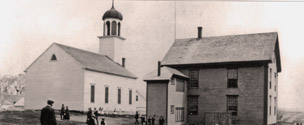Businesses and Owners
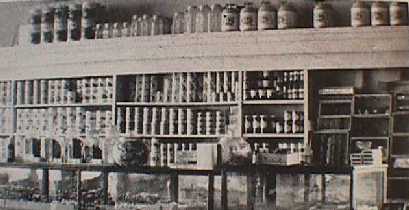
The above picture is of the interior of the Lysle P. Temple Store in the K. of P. Building on Main Street. The store was opened by his father Mr. Joseph Temple in 1904 and the business was taken over by Lysle in 1923. The store was always a favorite meeting place for old and young. Lysle and Ethel retired in 1939 and sold the stock from the store to Delmar Curtis and moved to Brunswick. They now live in Florida where they moved in 1953.
Charles H. McEwen
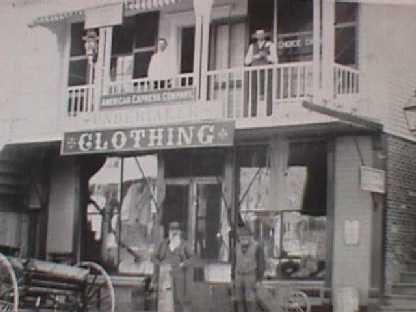
Donnell Building. pictured on the second story porch are George Sawyer and Charles H. McEwen. On the platform are Samuel Donnell and a delivery man.
Mr. Charles H. McEwen, who practiced barbering for more than 60 years, came to Bowdoinham in 1894. He learned his trade in Augusta from M. O. Savage in the Hotel North at the early age of 15. He worked for George Shaw in Richmond, for Chester Orr at the Falmouth Hotel in Portland, and spent two years under John Whelan at Young's Hotel in Boston, Mass. He opened his own shop in Purington's Store in Bowdoinham. In 1897 he moved to the Donnell Block then to the Carr Building where he was burned out in the fire of 1902. He took up temporary quarters in the Donnell Block until the Carr Building was rebuilt. Here he remained until 1924 when he purchased the building which had been Henry Cornish's Drug Store. In May 1949 poor health forced him to retire.
An interesting feature of Mr. McEwen's shop was the collection of shaving mugs bearing, in gilt letters, the names of the owners. Some also had a picture to indicate the owner's trade; for example: that of John Carney bore a fat cluster of cigars. Owners of mugs whose names were known outside of Bowdoinham were Stephen W. Carr, State Fire Commissioner, Captain Horatio Hall, William B. Kendall, Tyng W. Fogg and Lewis M Fulton.
During his early years here he needed assistance, so he taught his trade to George Sawyer, who later went to Auburn, Erland Powers, who went to Sanford and Robert Ferguson who worked with him 10 years before becoming a rural letter carrier from the local Post Office.
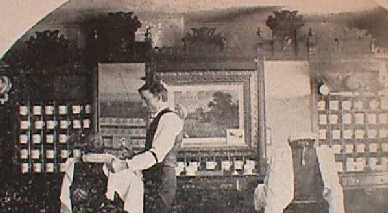
Charles H McEwen's shop in the Carr building on the corner of Main and Elm Streets before the 1902 fire.
In 1899 Mr. McEwen married Evelyn Ford Williams of Bowdoinham. They had two sons, Charles M. of Arlington, Mass., and Ralph H. and a daughter Ruth L. of Bowdoinham.
Mr. McEwen's activities included more than barbering. As a breeder of Rhode Island Red's he won 33 first prize ribbons from Maine fairs, a second from the Springfield, Mass. Exposition and several lesser awards.
He was a member of Merrymeeting Grange, also a charter member of the Bowdoinham Camp of the Modern Woodmen of America serving as Councilor for many years. He served as Chancellor Commander of Kennebec Lodge, No. 42, K. of P.
He took an active part in politics, serving as chairman of the Democratic Town Committee for 22 years and chairman of the Sagadahoc County Democratic Committee for 18 years. His interest in town affairs was varied. As a fireman he brought home many prizes from musters with Bowdoinham's ancient hand pump, the Water Witch. He was chief of the volunteer fire department for 29 years and directed the work of fighting the disastrous fires of 1902 and 1904. He served as president of the Bowdoinham Board of Trade, charter member and president of the Bowdoinham Relief Association, and Town Health Officer. He was the last surviving member of the Committee of Bowdoinham's 150th Anniversary Celebration in 1912.
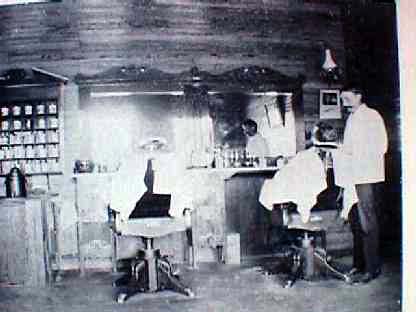
McEwen's shop in the Stephen Carr Building, after the "Big Fire."
Bicentennial Booklet 1962
James Ames
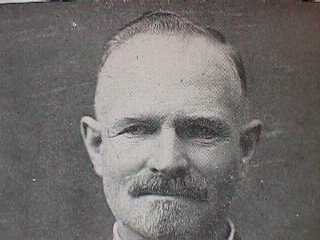
James H. Ames was born in Palermo, Maine, January 26, 1865. On December 29, 1888 he married Nettie C. Dodge of China, Maine. He and his wife raised a family of eight children; six of whom are still living.
In 1900, Mr. Ames and his family moved to Bowdoinham from Unity, where he had been a successful dairy farmer. While in Unity he had invented the Eureka Fly Killer, and came here to manufacture his Product. With W. B. Kendall and William Hutchins, he established the James H. Ames Company. The factory was located beyond the Sagadahoc Fertilizer Company on the Maine Central Railroad siding. For nearly fifty years this product was manufactured. Mr. Ames traveled extensively throughout the United States selling the Eureka Fly Killer. Prior to 1917, he made 10 trips across the continent. In the early 1900's he spent two years in California supervising operations in a silver mine. The "Judge" was a prominent businessman in Bowdoinham, and carried on a coal and insurance business in addition to manufacturing the Fly Killer.
In 1914 he was appointed Trial .justice by Governor William Haines. He served in this capacity until 1944. Twice Mr. Ames ran for Governor on the prohibition ticket. Although he failed to win this election either time, he was very proud of his work connected with prohibition. For 35 years he was superintendent of the Methodist Church Sunday School and was a noted figure in church activities until his death on March 22, 1944.
Bicentennial Booklet 1962
Josiah M. Fulton
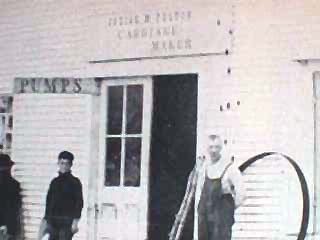
Josiah Fulton standing in front of wheel tire.
Josiah M. Fulton was born in Bowdoinham, April 24, 1852. He was the oldest son of Nancy Merrow and George Fulton and a favorite grandchild of Col. Josiah Merrow. When he was six months of age the family moved to Bowdoin and occupied the Fulton farm for many years.
As a young man he disliked farming and worked for some time in the car shop at Bath, Maine, where he learned to be a careful workman. Later he had his own shop in the old bank building in Bowdoinham. After the fire in 1902 he moved his work to the Bibber shop on Bridge street, a building just beyond the Gray homestead now occupied by Perlie Harmon and his step daughter Ruth Palmer.
A few years later A. G. Gowell, a local carpenter who lived on Bridge Street, built a large carriage shop just below the Fulton home on Center Street which had been previously built around the year 1890. He continued work in this shop until March 1926 when he died suddenly of pneumonia.
Josiah M. Fulton and Adria A. Frost were married July 14, 1885. They had one child, a daughter, Edith Louisa, now Mrs. Norman L. Rowe of Bowdoinham. A grandson, George F. Rowe, and a great-grandchild, Leona L. Rowe, now living in Bowdoinham.
Josiah M. Fulton was a quiet friendly man with many friends. He was a charter member of Kennebec Lodge No. 42, Knights of Pythias and remained a loyal, interested member until his death.
The Sampson Store, one of the oldest buildings in the village, was used for the Village Bank of Bowdoinham, the bank occupying the half next to the railroad. After August 28, 1890 the bank went into voluntary liquidation and closed up its business. The selectmen of Bowdoinham occupied a part of the old building for twenty years.
Josiah M. Fulton had his carriage shop in the part previously used by the bank. On December 14, 1902 the building was destroyed by fire.
Bicentennial Booklet 1962
Rufus Alonzo Dickinson
Rufus Alonzo Dickinson, better known to his friends as "Dick" or "Lonnie," was born in Bowdoinham, on November 18, 1866, the son of Rufus H. and Mary L. Hunt Dickinson. His youth and early married life was spent on the farm where he was born. Situated on the White Road, almost directly opposite the Gray Cross Road Turn, this farmstand burned in the early 1930's.
As a young man, he worked for a number of years with the ice-cutting business kept cows and sold milk in the village, ran a grist mill for a time and sold insurance as a sideline. In 1890 he married Carrie Evelyn Tarr of Bowdoin.
A few years later he sold his farm on the White Road and moved to the McFarland farm on the Fisher Road, now the home of Mrs. Margaret Gile.
He always took a keen interest in town affairs and in 1905 was elected Road Commissioner, a position he held until 1920. He also served on the board of selectmen, filling the post of chairman from 1918 until 1926.
In 1909, he moved his family from the Fisher Road to the village and in September of that year he purchased the stock of the General Store from Stone and Plummer. This business was located on the ground floor of the Masonic building, on the southeast corner of Bridge and Main Streets, and was formerly operated by William H. Gould, father of Mrs. Caleb Mitchell.
Mr. Dickinson continued business in that store for thirty years, then he purchased the building across the street and moved his stock there. That building, still Dickinson's Store, was the office of William B. Kendall and also at one time housed a barber shop, the Post Office and an insurance office.
Upon his retirement in 1959, "Dick" had conducted his business for exactly fifty years, most of those years on a seven-days-a-week basis, since his store sold, and still sells, Sunday papers.
Mr. Dickinson was a cheerful, kind and generous man and many families in town were given a helping hand when the going was rough. In all the years he tended store, he was never too busy to give attentive assistance to the small children who came in to make an investment in penny candy, of which he always kept a good assortment. After his retirement, he kept alert and was always pleased to see the many friends who called on him to talk politics, town affairs or old times.
R. A. Dickinson passed away at his home on Main Street, on March 16, 1960, at the age of 93. His wife having passed away in 1943, he is survived by two daughters, Dorothy Dickinson, proprietor of Dickinson's store and Mrs. Elsie Rendall, who resides in Augusta.
Bicentennial Booklet 1962
The Cornish Store
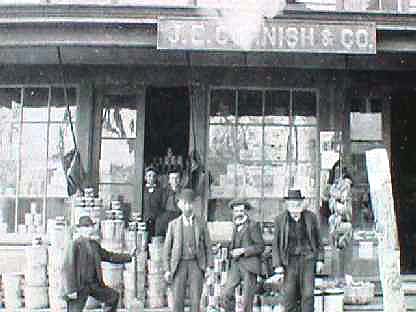
The so-called Cornish store was bought in 1880 by T. E. Cornish from Merryman Potter. Who sold half of the building and stock for $1,000. The grocery stock was small amounting to $150. Mr. Hillman occupied the other half of the store as a harness shop. Later "Ed" Cornish bought the other half of the building. From then until the death of Bert Cornish in 1936 the store was owned and operated by the Cornish's.
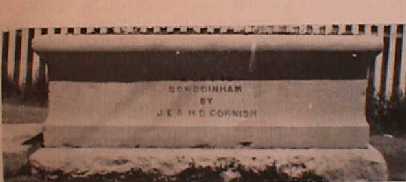
Watering trough presented to the town by J. E. and H. D. Cornish.
Bicentennial Booklet 1962
The Sagadahoc Fertilizer Company
The Sagadahoc Fertilizer Co., was established in 1880 and consisted of Wm. B. and Edward P. Kendall. It was located in the old plaster mill on the Cathance River across from the bridge. The first batch of fertilizer was mixed in a tin pail, and stirred with an iron spoon. The Dirigo fertilizer for grass and grain was the first brand made, and proved very successful. The old factory burned and the new one was built on its present location.
The business was sold twice, but the name Sagadahoc Fertilizer Co., has been maintained. At the present time a prosperous business is carried on under the management of Avery M. Fides, Gen'l Mgr., Orr's Island, Maine.
The W. B. and E. P. Kendall grain mill was located on the opposite side of the Cathance River from the fertilizer factory and near the railroad tracks. The power for grinding the corn was supplied by a tide water wheel, which was invented by James M. Kendall who formerly carried on the grain business. The mill burned in 1907, and the business was moved to a large shed nearby where it was conducted until it was moved to the new mill, which is now occupied by the E. Andrew Peterson Co., Patent Leather Finishers.
In Bowdoinham was located one of the State's outstanding sheep ranches, Long Branch Sheep Farm, owned by William B. Kendall, one of Maine's far seeing men. For many years Mr. Kendall worked at the sheep raising in Maine. He contended that sheep could be raised here to as great advantage as in the old days. Gradually his belief and efforts bore fruit until it was the largest sheep farm in New England. He raised not only grades but registered sheep, and won many blue ribbons at the Fairs.
GEORGIA DENHAM
Bicentennial Booklet 1962
William H. Gould
William H. Gould was born in Bowdoinham, October 20, 1863, the son of Harvey and Marcia Sally Gould. When he was fourteen years old, he went to work in the Coat Factory for Mr. Brackett and S. W. Carr, where he remained about twelve years.
In 1892 he bought out the tinware and stove shop business of W. H. Blasland, and five years later leased the Purington store, which was at the corner of Bridge and Main Streets. Here he had one of the most well stocked stores in town, carrying a complete line of tinware, stoves, hardware, and paints. Shortly after this, he leased the store adjoining the Purington Store, which was owned by Heatherly Hinkley, and he carried on a prosperous grocery business in this establishment.
Mr. Gould was engaged in business at this location in 1902 when the largest fire in Bowdoinham's history destroyed the buildings owned by Purington and Hinkley, and he lost a considerable amount of merchandise. Following the fire he moved to the Merrow Store, and in 1904 a second fire swept through part of the business district, and the store and Gould's stock of groceries were destroyed.
About 1904 Mr. Gould became an undertaker and his funeral parlor was located on Main Street. Later he carried on this business at his home on the Post Road. Mr. Gould was a member of the 2nd Baptist Church, and was always active in church circles. He belonged to the Village Lodge of Masons, Eastern Star, Merrymeeting Grange, Sons of Veterans and Kennebec Lodge Knights of Pythias.
He married Josephine Chapman in June 1899 and they had two children. In later life he married May Heenie and they lived on his farm on the Post Road until his death on May 19, 1950.
Bicentennial Booklet 1962
W. S. Carr Coat Shop 1901
Mr Carr was one of our smart business men who owned and operated the coat shop, hiring women and men.
Men's coats were made here, mostly of summer weight material because they were worn by men working in hotels and summer places.
The coats came all cut out. The shop was equipped with power machines to sew the coats together. Each woman had a certain part to do. The pressing and ironing was all done by hand. The irons used were the old-fashioned kind which had to be heated on a coal stove. It took a long time to get them hot enough to press and iron properly.
When one hundred coats were ready, they were packed in a large carton and sent to New York.
The building was located at the corner of Main and Elm Streets which is now the site of R. A Dickinson's store.
Bicentennial Booklet 1962
Dinsmore's Mill
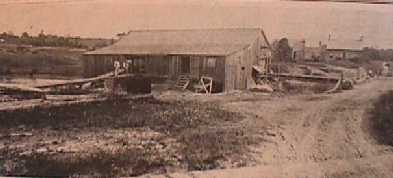
Dinsmore's mill at the head of the Abagadassett River. Picture taken about 1880. Saw and grist mills were operated on this site for over 100 years.
